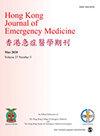新型冠状病毒肺炎期间急诊医学本科教学中的虚拟患者模拟:随机对照试验
IF 0.8
4区 医学
Q4 EMERGENCY MEDICINE
引用次数: 0
摘要
目的:探讨为期2周或4周的虚拟患者模拟课程是否能提高新冠肺炎期间急诊医学本科教学的临床能力。方法:该随机对照试验于2021年10月至12月进行。最后一年级医学生按1:1的比例随机分为2周短暴露组和4周长暴露组。在虚拟患者模拟学习程序之前和之后,使用具有结构化评分系统的虚拟病例对他们进行评估。在课程结束时,还对学习者的认知进行了问卷调查。结果:共招募学生138人。虚拟患者模拟程序后,长时间暴露组的虚拟病例评分增量显著高于短时间暴露组,平均评分差为18/100(95%置信区间= 9.8 ~ 26.3)。问卷调查结果显示,学生对急诊医学教学中使用虚拟病人模拟程序普遍持积极态度。结论:为期2周和4周的虚拟现实学习可能有利于提高医学生的急诊医学临床能力,特别是在COVID-19大流行等临床暴露有限的时期。为期4周的虚拟病人模拟课程对临床能力的学习效果较好。本文章由计算机程序翻译,如有差异,请以英文原文为准。
Virtual patient simulation in undergraduate emergency medicine education during COVID-19: Randomized controlled trial
Objective: To examine whether a 2-week or 4-week virtual patient simulation program can improve clinical competence for undergraduate emergency medicine education during COVID-19. Methods: This randomized controlled trial was conducted between October and December 2021. Final-year medical students were randomized into a 2-week short exposure group and a 4-week long exposure group on a 1:1 allocation. They were assessed using a virtual case with structured scoring system before and after the virtual patient simulation learning program. An end-of-program questionnaire on learners’ perceptions was also administered. Results: A total of 138 students were recruited. After the virtual patient simulation program, the virtual case score increment in the long exposure group was significantly higher than in the short exposure group with a mean score difference of 18/100 (95% confidence interval = 9.8 to 26.3). Questionnaire showed generally positive perceptions toward the use of virtual patient simulation program for emergency medicine teaching. Conclusion: Virtual reality learning of 2 and 4 weeks’ duration may be beneficial for improving emergency medicine clinical competence for final-year medical students, especially during periods of limited clinical exposure like the COVID-19 pandemic. A longer 4-week virtual patient simulation program may produce a better learning effect on clinical competence.
求助全文
通过发布文献求助,成功后即可免费获取论文全文。
去求助
来源期刊

Hong Kong Journal of Emergency Medicine
EMERGENCY MEDICINE-
CiteScore
1.50
自引率
16.70%
发文量
26
审稿时长
6-12 weeks
期刊介绍:
The Hong Kong Journal of Emergency Medicine is a peer-reviewed, open access journal which focusses on all aspects of clinical practice and emergency medicine research in the hospital and pre-hospital setting.
 求助内容:
求助内容: 应助结果提醒方式:
应助结果提醒方式:


